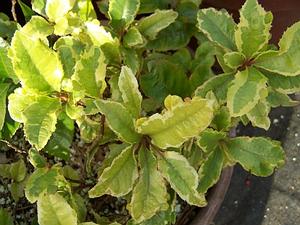Printed at http://www.quackingrassnursery.com/index.cfm/
Ardisia japonica 'Hinadi'
Coralberry
Plant Type:
BROADLEAF EVERGREEN SHRUBSArdisia japonica 'Hinadi' - Pinkish yellow new leaves unfold and mature green with irregular gold markings often evident as a flame in the central portion of each leaf. Pink flowers give way to gorgeous bright crimson persistent berries which look like little perfect apples. Ardisia is an under-appreciated evergreen ground cover. We wish we could grow it well but, alas, we are a tad too-far north and our winters are just too cold. Where it can be grown consider trying it for it will soon leave you spellbound. Perfect planted in fertile, moisture-retentive soil set in dappled to open shade. Early morning sun is fine - just keep it out of harsh midday and afternoon sun. Occasional short term dryness will be okay but arid condition is an anathema to keeping a garden carpet happy. Established potted plant from cutting.
Characteristics and Attributes for Ardisia japonica 'Hinadi'
Season of Interest (Flowering)
- Summer
Season of Interest (Foliage)
- Four Seasons
Autumn Interest
- Fruit / Berries / Seed Heads
Light
- Dappled Shade
- Morning Sun / Afternoon Shade
- Shade
Attributes
- Massing
- Bank
- Border
- Edging
- Evergreen
- Ground Cover
Growth Rate in the Garden
- Moderately Fast
Soil
- Moist
- Fertile
- Humus Laden
- Draining
- Organic
Origins
- Garden Origin
Propagated By
- Cutting Grown
Genus Overview: Ardisia
Family: Primulaceae · Common Name: Coralberry, Marlberry
Ardisia japonica, known commonly as Coralberry and Marlberry, is a shrubby, ground covering member of Primulaceae. Numerous species exist from the New World, the Pacific Islands, Australia, Asia with a vast number of species occurring in the tropics. We grow a number of fine selections from the species, A. japonica. These grow from 10 to 16(+) inches tall. Leaves are usually whorled or at least in an opposite template. Late spring flowers are pale pink to white, though small they are quite pretty and are held in racemes. The fruit that follows transforms from green to brilliant red and is persistent. "Berries" can approach the size of a dime and sometimes a little large. They are rounded and look like miniature apples. Ardisia, in its 2,500 year history of Chinese folk medicine, considers Ardisia japonica as one of the 50 fundamental herbs. We generally grow it for its phenomenal ornamental character. They are resplendent as they ground cover in shady, dappled or early morning or late day sun. Late morning to latish afternoon filtered light is important. Fertile, moisture retaining ground is a requirement. The many selections provide delight in their ground covering capacity. Not as well appreciated in U.S. gardens these plants are worthy where they can be grown outdoors. But potted plants allow for close up appreciation for their many merits - 4 season interest for sure - farther north if a cool window, porch, greenhouse or conservatory are part of your domain. USDA climate zones 7 to 9(10).



